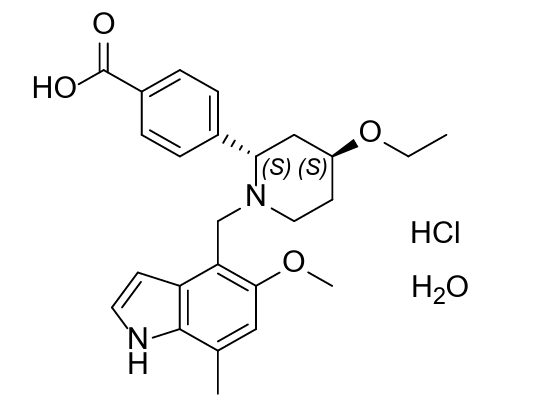FABHALTA is a complement factor B inhibitor, indicated for the treatment of adults with paroxysmal nocturnal hemoglobinuria (PNH).
DOSAGE AND ADMINISTRATION
Capsules: 200 mg of iptacopan
in pale yellow, opaque, hard gelatin capsules imprinted with “LNP200” on the
body and “NVR” on the cap.
API
Iptacopan
hydrochloride monohydrate is white or almost white to pale purplish-pink powder
that is slightly soluble in water at 25oC.
COMPOSITION - INGREDIENTS
Each FABHALTA capsule contains
200 mg iptacopan (provided as 225.8 mg iptacopan hydrochloride monohydrate) and
the capsule shell contains the following inactive ingredients: gelatin, red
ferric oxide, titanium dioxide, yellow ferric oxide.
PK
Absorption Following oral administration, iptacopan reached
peak plasma concentrations approximately 2 hours post dose. At the recommended
dosing regimen of 200 mg twice daily, steady state is achieved in approximately
5 days with minor accumulation (1.4-fold).
Effect of Food Based on a food-effect study in healthy
volunteers, a high-fat meal did not affect the exposure of iptacopan to a
clinically meaningful degree.
Elimination
The half-life (t1/2) of iptacopan at steady state is
approximately 25 hours after administration of FABHALTA 200 mg twice daily. The
clearance of iptacopan at steady state is 7.96 L/h after administration of
FABHALTA 200 mg twice daily.
Metabolism
Metabolism is a predominant elimination pathway for
iptacopan with approximately 50% of the dose attributed to oxidative pathways.
Metabolism of iptacopan includes N-dealkylation, O-deethylation, oxidation, and
dehydrogenation, mostly driven by CYP2C8 (98%) with a small contribution from
CYP2D6 (2%). Iptacopan undergoes Phase 2 metabolism through glucuronidation by
UGT1A1, UGT1A3, and UGT1A8.
Excretion
In a human study, following a single 100 mg oral dose of
[14C]-iptacopan, mean total excretion of radioactivity (iptacopan and
metabolites) was 71.5% in the feces and 24.8% in the urine, for a total mean
excretion of >96% of the dose. Specifically, 17.9% of the dose was excreted
as parent iptacopan in the urine, and 16.8% of the dose was excreted as parent
iptacopan in feces.
Linearity/Non-linearity
At doses between 25 mg and 200 mg twice daily, iptacopan
was overall less than dose proportional. However, oral doses of 100 mg and 200
mg were approximately dose proportional.
ADVERSE REACTIONS
The following clinically significant adverse reaction is
discussed in greater detail in other sections of the labeling: • Serious
Infections Caused by Encapsulated Bacteria [see Warnings and Precautions
(5.1)]. • Hyperlipidemia [see Warnings and Precautions
ORANGE BOOK
9682968 (Exp 07/14/2034) – a chemical patent
11603363 (Exp 05/25/2041) – related to crystallinity
POTENTIAL SALES
Anti-C5 drugs like Soliris and Ultomiris are currently used for PNH.
Novartis estimates that
there are roughly 6,000 PNH patients in the U.S., about one-third of whom it says are treated with
complement inhibitors. It hopes to supplant those drugs, as well as increase
the treatment rate in the 70% of patients who aren’t already on therapy.
It is believed that the annual Fabhalta sales will eventually top $3 billion.


